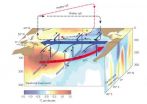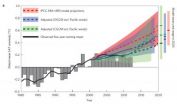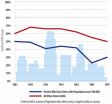(Press-News.org) Heat stored in the western Pacific Ocean caused by an unprecedented strengthening of the equatorial trade winds appears to be largely responsible for the hiatus in surface warming observed over the past 13 years.
New research published today in the journal Nature Climate Change indicates that the dramatic acceleration in winds has invigorated the circulation of the Pacific Ocean, causing more heat to be taken out of the atmosphere and transferred into the subsurface ocean, while bringing cooler waters to the surface.
"Scientists have long suspected that extra ocean heat uptake has slowed the rise of global average temperatures, but the mechanism behind the hiatus remained unclear" said Professor Matthew England, lead author of the study and a Chief Investigator at the ARC Centre of Excellence for Climate System Science.
"But the heat uptake is by no means permanent: when the trade wind strength returns to normal - as it inevitably will - our research suggests heat will quickly accumulate in the atmosphere. So global temperatures look set to rise rapidly out of the hiatus, returning to the levels projected within as little as a decade."
The strengthening of the Pacific trade winds began during the 1990s and continues today. Previously, no climate models have incorporated a trade wind strengthening of the magnitude observed, and these models failed to capture the hiatus in warming. Once the trade winds were added by the researchers, the global average temperatures very closely resembled the observations during the hiatus.
"The winds lead to extra ocean heat uptake, which stalled warming of the atmosphere. Accounting for this wind intensification in model projections produces a hiatus in global warming that is in striking agreement with observations," Prof England said.
"Unfortunately, however, when the hiatus ends, global warming looks set to be rapid."
The impact of the trade winds on global average temperatures is caused by the winds forcing heat to accumulate below surface of the Western Pacific Ocean.
"This pumping of heat into the ocean is not very deep, however, and once the winds abate, heat is returned rapidly to the atmosphere" England explains.
"Climate scientists have long understood that global average temperatures don't rise in a continual upward trajectory, instead warming in a series of abrupt steps in between periods with more-or-less steady temperatures. Our work helps explain how this occurs," said Prof England.
"We should be very clear: the current hiatus offers no comfort - we are just seeing another pause in warming before the next inevitable rise in global temperatures."
INFORMATION: END
Pacific trade winds stall global surface warming -- for now
The strongest trade winds have driven more of the heat from global warming into the oceans; but when those winds slow, that heat will rapidly return to the atmosphere causing an abrupt rise in global average temperatures
2014-02-10
ELSE PRESS RELEASES FROM THIS DATE:
Seven new genetic regions linked to type 2 diabetes
2014-02-10
Seven new genetic regions associated with type 2 diabetes have been identified in the largest study to date of the genetic basis of the disease.
DNA data was brought together from more than 48,000 patients and 139,000 healthy controls from four different ethnic groups. The research was conducted by an international consortium of investigators from 20 countries on four continents, co-led by investigators from Oxford University's Wellcome Trust Centre for Human Genetics.
The majority of such 'genome-wide association studies' have been done in populations with European ...
Optogenetic toolkit goes multicolor
2014-02-10
CAMBRIDGE, MA -- Optogenetics is a technique that allows scientists to control neurons' electrical activity with light by engineering them to express light-sensitive proteins. Within the past decade, it has become a very powerful tool for discovering the functions of different types of cells in the brain.
Most of these light-sensitive proteins, known as opsins, respond to light in the blue-green range. Now, a team led by MIT has discovered an opsin that is sensitive to red light, which allows researchers to independently control the activity of two populations of neurons ...
Clues to cancer pathogenesis found in cell-conditioned media
2014-02-10
Philadelphia, PA, February 10, 2014 – Primary effusion lymphoma (PEL) is a rare B-cell neoplasm distinguished by its tendency to spread along the thin serous membranes that line body cavities without infiltrating or destroying nearby tissue. By growing PEL cells in culture and analyzing the secretome (proteins secreted into cell-conditioned media), investigators have identified proteins that may explain PEL pathogenesis, its peculiar cell adhesion, and migration patterns. They also recognized related oncogenic pathways, thereby providing rationales for more individualized ...
Smoking linked with increased risk of most common type of breast cancer
2014-02-10
Young women who smoke and have been smoking a pack a day for a decade or more have a significantly increased risk of developing the most common type of breast cancer. That is the finding of an analysis published early online in Cancer, a peer-reviewed journal of the American Cancer Society. The study indicates that an increased risk of breast cancer may be another health risk incurred by young women who smoke.
The majority of recent studies evaluating the relationship between smoking and breast cancer risk among young women have found that smoking is linked with an increased ...
No strength in numbers
2014-02-10
Urban legislators have long lamented that they do not get their fair share of bills passed in state governments, often blaming rural and suburban interests for blocking their efforts. Now a new study confirms one of those suspicions but surprisingly refutes the other.
The analysis—of 1,736 bills in 13 states over 120 years—found that big-city legislation was passed at dramatically lower rates than bills for smaller places.
However, rural and suburban colleagues should not be blamed for the dismal track record, conclude co-authors Gerald Gamm of the University of Rochester ...
Virtual avatars may impact real-world behavior
2014-02-10
How you represent yourself in the virtual world of video games may affect how you behave toward others in the real world, according to new research published in Psychological Science, a journal of the Association for Psychological Science.
"Our results indicate that just five minutes of role-play in virtual environments as either a hero or villain can easily cause people to reward or punish anonymous strangers," says lead researcher Gunwoo Yoon of the University of Illinois at Urbana-Champaign.
As Yoon and co-author Patrick Vargas note, virtual environments afford people ...
Huntington disease prevention trial shows creatine safe, suggests slowing of progression
2014-02-08
The first clinical trial of a drug intended to delay the onset of symptoms of Huntington disease (HD) reveals that high-dose treatment with the nutritional supplement creatine was safe and well tolerated by most study participants. In addition, neuroimaging showed a treatment-associated slowing of regional brain atrophy, evidence that creatine might slow the progression of presymptomatic HD. The Massachusetts General Hospital (MGH) study also utilized a novel design that allowed participants – all of whom were at genetic risk for the neurodegenerative disorder – to enroll ...
Stroke trigger more deadly for African-Americans
2014-02-08
ANN ARBOR, Mich. — Infection is a stronger trigger of stroke death in African- Americans than in whites, a University of Michigan study shows.
African-Americans were 39 times more likely to die of a stroke if they were exposed to an infection in the previous month when compared to other time periods while whites were four times more likely and Hispanics were five times more likely to die of stroke after an infection, according to the findings that appear online Feb. 7 in Neurology.
The most frequent infections were urinary, skin, and respiratory tract infections ...
Women fare worse than men following stroke
2014-02-08
WINSTON-SALEM, N.C. – Feb. 7, 2014 – The good news: More people survive stroke now than 10 years ago due to improved treatment and prevention.
The bad news: Women who survive stroke have a worse quality of life than men, according to a study published in the Feb. 7 online issue of the journal Neurology.
Researchers at Wake Forest Baptist Medical Center compared the quality of life in men and women who had a stroke or transient ischemic attack (TIA). A total of 1,370 patients ages 56 to 77 from the AVAIL registry – a national, multicenter, longitudinal registry of ischemic ...
New application of physics tools used in biology
2014-02-08
A Lawrence Livermore National Laboratory physicist and his colleagues have found a new application for the tools and mathematics typically used in physics to help solve problems in biology.
Specifically, the team used statistical mechanics and mathematical modeling to shed light on something known as epigenetic memory -- how an organism can create a biological memory of some variable condition, such as quality of nutrition or temperature.
"The work highlights the interdisciplinary nature of modern molecular biology, in particular, how the tools and models from mathematics ...
LAST 30 PRESS RELEASES:
Making lighter work of calculating fluid and heat flow
Normalizing blood sugar can halve heart attack risk
Lowering blood sugar cuts heart attack risk in people with prediabetes
Study links genetic variants to risk of blinding eye disease in premature infants
Non-opioid ‘pain sponge’ therapy halts cartilage degeneration and relieves chronic pain
AI can pick up cultural values by mimicking how kids learn
China’s ecological redlines offer fast track to 30 x 30 global conservation goal
Invisible indoor threats: emerging household contaminants and their growing risks to human health
Adding antibody treatment to chemo boosts outcomes for children with rare cancer
Germline pathogenic variants among women without a history of breast cancer
Tanning beds triple melanoma risk, potentially causing broad DNA damage
Unique bond identified as key to viral infection speed
Indoor tanning makes youthful skin much older on a genetic level
Mouse model sheds new light on the causes and potential solutions to human GI problems linked to muscular dystrophy
The Journal of Nuclear Medicine ahead-of-print tip sheet: December 12, 2025
Smarter tools for peering into the microscopic world
Applications open for funding to conduct research in the Kinsey Institute archives
Global measure underestimates the severity of food insecurity
Child survivors of critical illness are missing out on timely follow up care
Risk-based vs annual breast cancer screening / the WISDOM randomized clinical trial
University of Toronto launches Electric Vehicle Innovation Ontario to accelerate advanced EV technologies and build Canada’s innovation advantage
Early relapse predicts poor outcomes in aggressive blood cancer
American College of Lifestyle Medicine applauds two CMS models aligned with lifestyle medicine practice and reimbursement
Clinical trial finds cannabis use not a barrier to quitting nicotine vaping
Supplemental nutrition assistance program policies and food insecurity
Switching immune cells to “night mode” could limit damage after a heart attack, study suggests
URI-based Global RIghts Project report spotlights continued troubling trends in worldwide inhumane treatment
Neutrophils are less aggressive at night, explaining why nighttime heart attacks cause less damage than daytime events
Menopausal hormone therapy may not pose breast cancer risk for women with BRCA mutations
Mobile health tool may improve quality of life for adolescent and young adult breast cancer survivors
[Press-News.org] Pacific trade winds stall global surface warming -- for nowThe strongest trade winds have driven more of the heat from global warming into the oceans; but when those winds slow, that heat will rapidly return to the atmosphere causing an abrupt rise in global average temperatures




